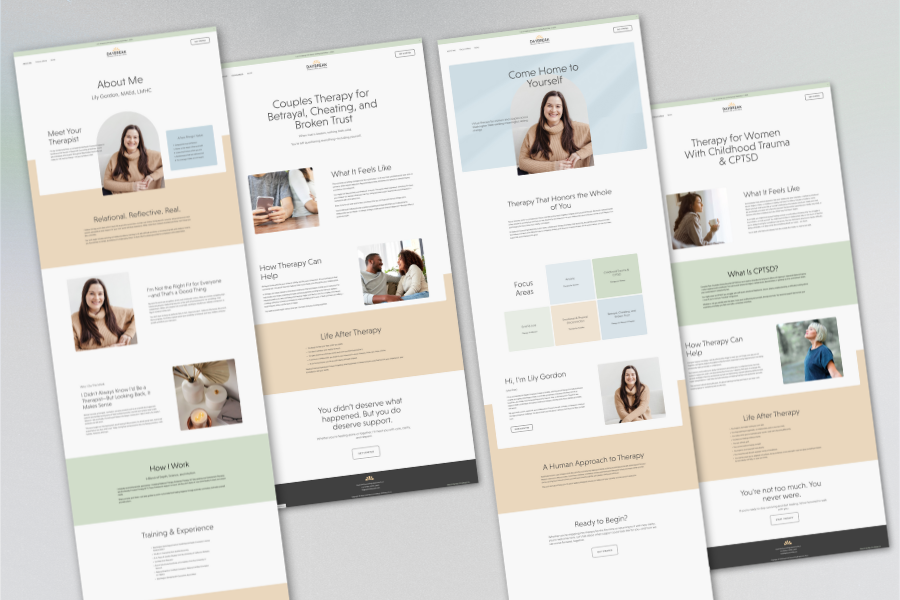How to Use Branding to Stand Out in a Saturated Therapy Market
How to Use Branding to Stand Out in a Saturated Therapy Market
Quick Answer for Skimmers (and Search Engines):
You don’t stand out by shouting louder—you stand out by being clear, consistent, and emotionally real. Branding for therapists isn’t just a logo—it’s the feeling and tone that make people recognize, trust, and actually want to reach out.
What this post covers:
We’ll walk through five key branding elements—feeling, niche clarity, messaging, visuals, and consistency—and show how they play together to create a brand experience that feels authentic, not over-polished. You’ll learn how to use branding as a tool for connection (not marketing), and when it’s time to get help sharpen your image.
In big cities like New York, Seattle, or LA, it can feel like every other person is a therapist—and every therapist has a website that looks and sounds the same. If you’ve ever wondered how the heck you’re supposed to stand out, you’re not alone.
The answer isn’t louder marketing or flashier graphics. It’s branding.
But not in the "corporate logo and tagline" way you might be thinking.
Branding, for therapists, is really about clarity, consistency, and connection—so that the right people recognize you, remember you, and reach out.
In this post, we’ll walk through how to use branding to rise above the noise in a saturated therapy market—without being salesy, inauthentic, or over-polished.
1. Branding Isn’t Just a Logo—It’s a Feeling
Your brand is the impression people get when they come across your website, your Instagram bio, or your Psychology Today profile.
It’s:
How you describe your work
The way your visuals feel (calming, edgy, warm, grounded, etc.)
The emotional tone of your writing
What you’re known for
For therapists, branding isn’t about slick marketing. It’s about making it easier for the right people to find you and feel a sense of trust—fast.
2. A Clear Niche Is the Fastest Way to Stand Out
In a city full of generalists, a specific focus is a competitive edge.
Therapists often worry that choosing a niche will limit their practice—but in reality, a clear focus helps the right clients self-select in (and makes your marketing way easier).
Strong niche examples:
“Therapy for first-generation professionals navigating identity and cultural expectations”
“Support for women healing from high-control religious experiences”
“ADHD-focused therapy for creative entrepreneurs who feel like they’re drowning in ideas”
Your niche doesn’t have to be narrow—it just needs to be recognizable.
3. Your Message Should Be Memorable, Not Generic
Look at your website headline, your IG bio, or the first sentence on your Psychology Today page. Ask yourself:
Could any therapist say this?
Or does this sound uniquely like me?
Example:
✘ “I provide a safe, supportive space to explore your emotions.”
✔︎ “We get to the root of why you keep ending up in the same kind of relationship—so you can finally break the pattern.”
Specificity builds trust. Clarity builds confidence. A memorable message helps clients remember you when they’re scrolling through 10 open therapy tabs.
Blends in…
Stands out…
4. Your Visuals Should Match the Emotional Tone of Your Work
Whether we realize it or not, we all make snap decisions about a therapist’s vibe based on their visuals.
If your brand colors, fonts, and photos feel disconnected—or don’t match the emotional experience of your work—it creates friction.
For example:
A trauma-informed therapist with deep, grounding energy might use rich, earthy tones and soft serif fonts.
A therapist who works with creatives or neurodivergent clients might go bold, playful, and color-rich.
The goal isn’t to “look professional.” The goal is to look and feel like you—in a way that resonates with your ideal clients.
Unclear brand…
Emotionally aligned…
5. Consistency Builds Trust (and Recognition)
Your brand should carry across every touchpoint, including:
Your website
Your email signature
Your social media bios
Directory profiles
Brochures, flyers, and business cards
If someone finds your IG and clicks through to your site, it should feel like the same person is greeting them. When your visuals and message are consistent, clients feel more trust.
6. When to Invest in Professional Branding Help
You don’t need a $5,000 branding package to start. But you might want support if:
You feel too close to your work to describe it clearly
You're rebranding to specialize or pivot niches
You want a website that actually reflects your personality and strengths
You’re tired of duct-taping a brand together with Canva and guesswork
Hiring a copywriter, brand designer, or website strategist can help you distill your voice and create a presence that attracts the right people without you having to explain yourself over and over.
7. Branding Is a Tool for Connection, Not Just Marketing
Branding isn’t about manipulation—it’s about communication. It’s the bridge between:
What you offer
And what your future clients need to hear to feel safe reaching out
Done well, your brand quietly tells people:
“This therapist gets me. I want to learn more.”
And that’s all it takes to stand out in a saturated market.
Ready to Make Your Brand Work for You?
If you’re a therapist who wants your website, message, and visuals to finally feel like you, here are a few next steps:
Download my free Brand Strategy Workbook
Explore the website templates in my shop
Reach out about working together on a custom One-Day Website
Standing out doesn’t require being the loudest. Just the clearest.
And the most you.
Pin it!
Some of My Favorite Private Practice Tools
Resources and Referral Links

















































